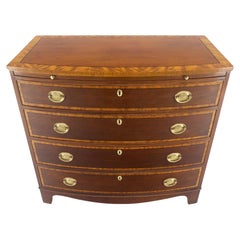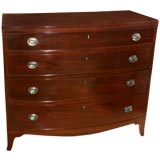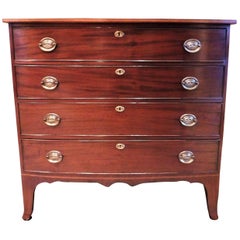Federal Bow Front Chest
Antique 19th Century Unknown Federal Commodes and Chests of Drawers
Brass
20th Century American Federal Dressers
Brass
Recent Sales
Antique 19th Century American Commodes and Chests of Drawers
Mahogany
Antique Late 18th Century American Hepplewhite Commodes and Chests of Dr...
Mahogany
Antique Late 18th Century American Federal Commodes and Chests of Drawers
Antique 19th Century American Federal Commodes and Chests of Drawers
Mahogany
Antique Early 19th Century American Sheraton Commodes and Chests of Drawers
Birdseye Maple, Mahogany
Antique Late 18th Century American Sheraton Commodes and Chests of Drawers
Birch, Mahogany
Antique Early 19th Century American Federal Commodes and Chests of Drawers
Brass
Antique Early 19th Century American Federal Commodes and Chests of Drawers
Brass
Mid-20th Century American Federal Commodes and Chests of Drawers
Mahogany
Early 20th Century American Federal Commodes and Chests of Drawers
Brass
Mid-20th Century American Federal Commodes and Chests of Drawers
Brass
Antique Early 19th Century American Federal Dressers
Mahogany
Antique 1790s American Federal Commodes and Chests of Drawers
Mahogany
Antique 1810s American Federal Bathroom Fixtures
Brass, Nickel
Antique 18th Century Federal Commodes and Chests of Drawers
Mahogany, Poplar, Pine
Antique Early 19th Century American Federal Commodes and Chests of Drawers
Brass
Antique Early 19th Century American Federal Commodes and Chests of Drawers
Brass
Antique Early 19th Century American Federal Commodes and Chests of Drawers
Brass
Antique Early 19th Century American Federal Commodes and Chests of Drawers
Mid-20th Century American Federal Dressers
Brass
Vintage 1940s North American Federal Dressers
Mahogany
20th Century American Federal Dressers
Brass
Vintage 1980s American Georgian Night Stands
Brass
Antique 19th Century American Commodes and Chests of Drawers
Antique Early 19th Century American Federal Commodes and Chests of Drawers
Cherry
Antique 19th Century American Commodes and Chests of Drawers
Birch, Cherry, Mahogany
Antique Early 19th Century American Federal Commodes and Chests of Drawers
Mahogany
Antique Early 19th Century American Federal Commodes and Chests of Drawers
Mahogany
Antique Early 19th Century American Federal Commodes and Chests of Drawers
Cherry
Antique 19th Century Commodes and Chests of Drawers
Mahogany
Antique 1850s Federal Commodes and Chests of Drawers
Brass
Antique 19th Century American Federal Commodes and Chests of Drawers
Brass
Antique 19th Century American Federal Commodes and Chests of Drawers
Antique 18th Century and Earlier American Commodes and Chests of Drawers
Brass
Antique Late 18th Century American Hepplewhite Commodes and Chests of Dr...
Antique Early 19th Century American Federal Commodes and Chests of Drawers
Mahogany
Antique Early 19th Century American Federal Commodes and Chests of Drawers
Mahogany
Antique Late 18th Century American Federal Models and Miniatures
Brass
People Also Browsed
Antique 19th Century American Federal Dressers
Brass
Antique Late 18th Century Unknown George III Commodes and Chests of Drawers
Wood
Vintage 1960s American Georgian Dressers
Brass
Late 20th Century George III Dressers
Mahogany
Mid-20th Century North American Regency Dressers
Walnut
20th Century American American Classical Demi-lune Tables
Mahogany
Late 20th Century American Federal Side Tables
Brass
Mid-20th Century Edwardian Dressers
Mahogany
20th Century American Mid-Century Modern Commodes and Chests of Drawers
Brass
Early 20th Century Georgian Commodes and Chests of Drawers
Mahogany
Antique 1890s French Empire Commodes and Chests of Drawers
Mahogany
Vintage 1980s American Chippendale Commodes and Chests of Drawers
Brass
Antique Late 18th Century English Georgian Commodes and Chests of Drawers
Wood
Vintage 1980s American Georgian Night Stands
Brass
Vintage 1960s American Mid-Century Modern Dressers
Walnut
Vintage 1970s American American Colonial Dressers
Brass
Federal Bow Front Chest For Sale on 1stDibs
How Much is a Federal Bow Front Chest?
Finding the Right Commodes-chests-of-drawers for You
Shopping for a commode or a chest of drawers?
Commode is the French term for a low chest of drawers, but it is also sometimes used to denote any case piece with a particularly intricate design. The commode dates to circa 1700 France, where it was used as an alternative to a taller cabinet piece so as to not obscure paneled, mirrored or tapestried walls. Coffers, or chests, which were large wooden boxes with hinged lids and sometimes stood on ball feet, preceded chests of drawers, a fashionable cabinet furnishing that garnered acclaim for its obvious storage potential and versatility. The term commode was also used to refer to a piece of bedroom furniture — a washstand or nightstand that contained a chamber pot.
As time passed, French and British furniture makers led the way in the production of chests of drawers, and features like the integration of bronze and ornamental pulls became commonplace. Antique French commodes in the Louis XV style were sometimes crafted in mahogany or walnut, while an Italian marble top added a sophisticated decorative flourish. This specific type of case piece grew in popularity in the years that followed.
So, what makes a chest of drawers different from a common dresser? Dressers are short, and chests of drawers are overall taller pieces of furniture that typically do not have room on the top for a mirror as most dressers do. Tallboys and highboys are variations of the dresser form. Some chests of drawers have one column of four to six long drawers or three long drawers in their bottom section that are topped by a cluster of small side-by-side drawers on the top. To further complicate things, we sometimes refer to particularly short chests of drawers as nightstands.
Even though chests of drawers are commonly thought of as bedroom furniture to store clothing, these are adaptable pieces. A chest of drawers can house important documents — think of your walnut Art Deco commode as an upgrade to your filing cabinet. Nestle your chest near your home’s front door to store coats and other outerwear, while the top can be a place to drop your handbag. Add some flair to your kitchen, where this lovable case piece can hold pots, pans and even cookbooks.
When shopping for the right chest of drawers for your home, there are a few key things to consider: What will you be storing in it? How big a chest will you need?
Speaking of size, don’t dream too big. If your space is on the smaller side, a more streamlined vintage mid-century modern chest of drawers, perhaps one designed by Paul McCobb or T.H. Robsjohn-Gibbings, may best suit your needs.
At 1stDibs, we make it easy to add style and storage to your home. Browse our collection of antique and vintage commodes and chests of drawers today.
Read More
The Ultimate Guide to Types of Tables for the Home
Whether you’re just moving in or ready to give your home a makeover, our guide will give you pointers on tables that are fitting for every room, nook and hallway.
What Exactly Is a Secretary Desk, and What Is It Used For?
The furniture equivalent of a Swiss Army knife, it's the multifunctional piece you didn't know you needed.
This Shelving System with Oxidized Brass Tubes Is Retro and Futuristic at Once
Italian studio DimoreMilano mustered great ingenuity when crafting these sculptural shelves, which are built without any screws.
28 Cheerful Home Bars, Where Everybody (Literally) Knows Your Name
Simple or sophisticated, equipped with console, cart or custom cabinetry, these stylish bar areas deserve a toast.
Ask an Interior Designer: Work-from-Home Edition
Leaping into a design project, whether it's refreshing the bedroom or redoing the whole house, can be overwhelming. Luckily, we know more than a few interior designers. You asked questions on Instagram, and now they're answering.
Collected and Eclectic, ‘Wunderkammern’ Are Back in a Big Way
Introduced nearly 500 years ago, curiosity cabinets are finding new fans among today's collectors and designers.
Meet the Incredible Woman Transforming Fallen Trees into Sleek Furniture
In the hands of New York Heartwoods cofounder Megan Offner, unwanted local trees become works of design art.
These New York Architects Love a Complicated Project
From Brooklyn townhouses to Maine campgrounds, Trattie Davies and Jonathan Toews relish a challenge, like transforming a former warehouse space into the new 1stdibs Gallery.



